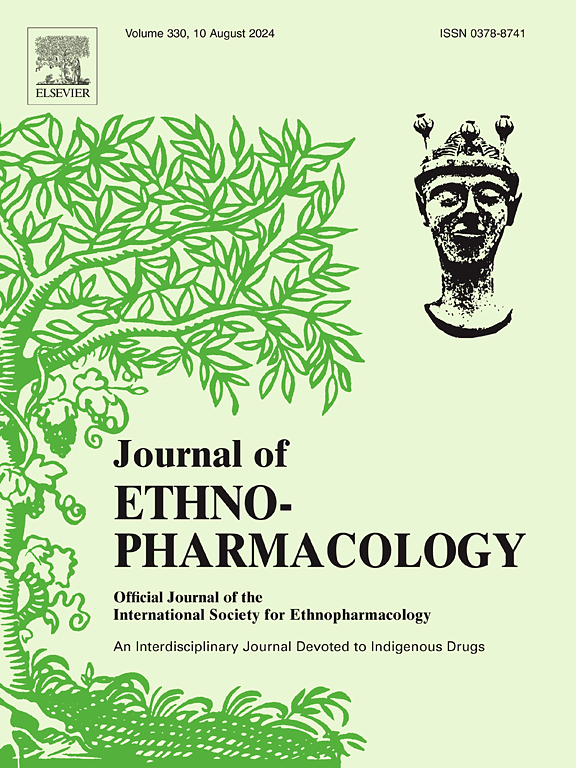芍日老清肺止咳胶囊通过MAPK信号通路缓解LPS和cs诱导的COPD炎症和支气管重构。
IF 4.8
2区 医学
Q1 CHEMISTRY, MEDICINAL
引用次数: 0
摘要
民族药理学相关性:慢性阻塞性肺疾病(COPD)是一种持续性炎性气道疾病,主要由长期暴露于有毒气体或颗粒引起。Saorilao清肺止咳胶囊(SRL)是一种源自蒙药的传统配方,具有治疗慢性支气管炎的良好临床疗效。然而,其在COPD治疗中的潜在作用尚不清楚。研究目的:本研究旨在通过网络药理学和实验验证来评估SRL治疗COPD的潜力和进一步的相关机制。材料与方法:本研究通过气管内灌注LPS联合暴露于CS诱导小鼠COPD。从第57天到第84天,小鼠分别用200、400和800 mg/kg的蒸馏水、NAC或SRL治疗。采用肺功能指标和组织病理学检查评价治疗效果。此外,我们还通过网络药理学以及体外和体内实验来探索SRL抗COPD的潜在机制。结果:研究表明SRL可改善COPD小鼠肺功能,降低肺指数。组织病理学分析显示,SRL可减少细胞凋亡、胶原积累、气道炎症和过多粘液产生,突出其在COPD治疗中的治疗潜力。RT-PCR分析显示,srl治疗的COPD小鼠Pro-Col I、Pro-Col III、TIMP-1和TIMP-2的表达明显降低。此外,Western blot分析显示,与正常对照组相比,COPD小鼠肺组织中p-Smad3、p-P38和p-JNK的表达水平显著增加,提示MAPK通路激活,这与网络药理学预测一致。此外,SRL处理明显抑制了这些蛋白的磷酸化,显著降低了α-SMA的表达。结论:首次报道SRL可能通过激活MAPK通路,具有治疗COPD的良好潜力。本文章由计算机程序翻译,如有差异,请以英文原文为准。
Saorilao Qingfei Zhike Capsule alleviated inflammation and bronchial remodeling in LPS and CS-induced COPD via MAPK signaling pathway
Ethnopharmacological relevance
Chronic obstructive pulmonary disease (COPD) is a persistent inflammatory airway disease primarily caused by prolonged exposure to toxic gases or particles. The Saorilao Qingfei Zhike Capsule (SRL), derived from a traditional Mongolian medicine recipe, has demonstrated promising clinical efficacy in treating chronic bronchitis. However, its potential role in COPD treatment remains unclear.
Aim of the study
This study aimed to assess the potential of SRL in treating COPD and further related mechanisms by utilizing network pharmacology and experimental validation.
Materials and methods
The study induced COPD in mice through intratracheal instillation of LPS combined with exposure to CS. From day 57 to day 84, the mice were treated with distilled water, NAC, or SRL at doses of 200, 400, and 800 mg/kg. Lung function indices and histopathological examinations were used to evaluate the therapeutic efficacy of the treatments. Furthermore, network pharmacology, along with in vitro and in vivo experiments, was conducted to explore the potential mechanisms by which SRL against COPD.
Results
The study demonstrated that SRL improved lung function and reduced lung index in COPD mice. Histopathological analysis revealed that SRL decreased apoptosis, collagen accumulation, airway inflammation, and excessive mucus production, highlighting its therapeutic potential in COPD treatment. RT-PCR analysis showed a marked decrease in the expression of Pro-Col I, Pro-Col III, TIMP-1, and TIMP-2 in SRL-treated COPD mice. Furthermore, Western blot analysis indicated a substantial increase in the expression levels of p-Smad3, p-P38 and p-JNK in the lung tissue of COPD mice compared to normal controls, suggesting activation of the MAPK pathway, which was consistent with network pharmacology predictions. Additionally, SRL treatment obviously suppressed the phosphorylation of these proteins and significantly reduced α-SMA expression.
Conclusion
It was firstly reported that SRL exhibited promising therapeutic potential for treating COPD, possibly through the activation of the MAPK pathway.
求助全文
通过发布文献求助,成功后即可免费获取论文全文。
去求助
来源期刊

Journal of ethnopharmacology
医学-全科医学与补充医学
CiteScore
10.30
自引率
5.60%
发文量
967
审稿时长
77 days
期刊介绍:
The Journal of Ethnopharmacology is dedicated to the exchange of information and understandings about people''s use of plants, fungi, animals, microorganisms and minerals and their biological and pharmacological effects based on the principles established through international conventions. Early people confronted with illness and disease, discovered a wealth of useful therapeutic agents in the plant and animal kingdoms. The empirical knowledge of these medicinal substances and their toxic potential was passed on by oral tradition and sometimes recorded in herbals and other texts on materia medica. Many valuable drugs of today (e.g., atropine, ephedrine, tubocurarine, digoxin, reserpine) came into use through the study of indigenous remedies. Chemists continue to use plant-derived drugs (e.g., morphine, taxol, physostigmine, quinidine, emetine) as prototypes in their attempts to develop more effective and less toxic medicinals.
 求助内容:
求助内容: 应助结果提醒方式:
应助结果提醒方式:


